Making my way south from Furnace Creek, I wasn't in any rush as I putzed along Badwater Road. With tourists swinging into the other lane to pass me by, I soaked in the ever-changing western face of the Black Mountains.

Is it just me, or does it look like that guy is fishing in Lake Manley? No fish out there buddy!
After passing the parking lot at Badwater, traffic thinned out significantly. Sure, there was still a bit - heading to or from Sidewinder Canyon or south towards Jubilee Pass and Las Vegas - but by and large I was no longer "in the way," and was thankful to have the desert to myself.

I really liked this little salt finger that stretched out into the lake below Telescope Peak, so I wandered out to the point for a picture.

When Lake Manley's around, it's like getting twice the beauty from the Black Mountains.

OK, I didn't quite have the desert to myself.
Eventually, I reached Ashford Junction. For 99% of folks, the destination here is a thousand feet into the valley at the site of the old Ashford Mill. So I headed the opposite direction - up the alluvial fan and towards the mouth of Ashford Canyon - through a field of flowers, and a windshield full of whimsy.

Even more colorful than usual, with large swaths of the hillsides covered in green.
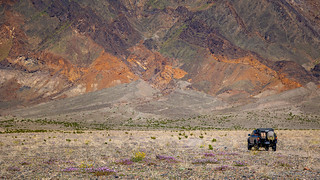
Sometimes I couldn't even see the sky.

Desert gold and sand verbena were doing their part on the valley floor.
I wasn't sure what to expect as far as road conditions were concerned. Most of the time this road is easily passable my nearly any vehicle, but I'd heard that there might have been some storm damage from Hillary the previous fall. My planned hike was going to be a lot longer if that turned out to be the case, so I was glad as I found myself pulling into the parking area at the wilderness boundary, the road seemingly in perfect condition the entire way!
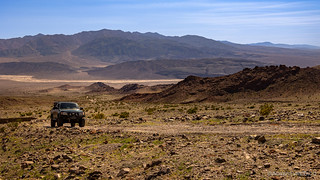
Up the alluvial fan.

Through the blooming creosote.

No surer way to yell spring in Death Valley than with a mountain of green.
Perhaps the most exciting thing for me - as I neared the end of the road - was a large lizard I noticed scurrying from one side to the other. It wasn't a scurry I was accustomed to - and boy, did that lizard seem larger than normal - so I popped out of the Tacoma to get a closer look.

My first chuckwalla!
My encounter with the chuckwalla wasn't quite as peaceful as my initial popping out of the Tacoma might make it seem. Having scurried across the road, he'd - I'll call him a "he" so my actions don't seem quite so rude - run into the bottom of a small drainage and hidden in a small clump of football-sized stones.
Hoping to move a stone or two in order to snap a quick shot and be on my way, you can imagine my surprise when I lifted the rock where he'd taken cover, and rather than run away from me, he jumped onto my foot! I'm not usually jumpy around lizards - I've been known to catch a thousand or two in my days roaming this rock - but oh my goodness, this thing was heavy.
Probably just as surprised as I was, Mr. Chuckwalla wasted no time in getting off my foot and wedged under another nearby rock. This time however, he made a mistake: he'd followed the advice of his ostrich friend and left his tail sticking out in the sun. It was a massive tail by the way.
Unsure if Chuckwalla shed their tails like some other lizards - and not knowing whether I was in for a nibble if I tried to pick him up - I tentatively reached down and grabbed his tail as close to the back legs as I could muster and hoped for the best. A little tugging and pretty soon I was holding the largest lizard I've ever caught. And by holding, I mean hoping to keep all my fingers.
Anyway, I got him back up to the largest open space I could find - the roadway - before setting him on the ground in the hopes that he'd take pity on my and allow a photo of two before he ran away again. No dice on that though - it seems my pulling-him-out-from-under-a-rock-by-his-tail wasn't something he was real happy about, and he immediately scurried to the nearest shelter available - under the Tacoma, and then up into one of the front wheels!
Shit.
Less than 15 seconds earlier I'd wanted to photograph a mini dinosaur, but I certainly had no intent of killing one as I drove away; my photo shoot quickly transformed into a rescue effort.
Luckily, Chucky didn't really love being in a wheel, either, and after a bit of rude stick poking on my part, he jumped down onto the ground. Still in the shade under the Tacoma, I could see through his little lizard eyes that his prehistoric brain was figuring out how to eat me.

Fear my tiny teeth. I am dinosaur. I shall eat you one bitty bite at a time!
Not wanting to be eaten, I snapped a couple quick photos, reminded him that he needed to watch his weight if he was going to win that Lovely Lizard of the Year award, and watched as he wiggled himself away and under a third nearby rock just off the road.
I'd survived.

By the time I got the Tacoma leveled out and ready for camp, my heart rate was finally returning to normal. For now.
It was two minutes before 4:00pm when I closed the door on the Tacoma and headed up the wash into Ashford Canyon. An old mine road wove its way in-and-out of the wash, but I figured that - as I had when @mrs.turbodb and I visited the Keane Wonder Mine - I'd hike up the wash and then return via the road. Or, if I encountered an obstacle in the wash that I couldn't overcome, that I would simply retrace my path to the nearest braid of the road and follow it from there.

With daylight savings time pushing sunset later by an hour ( ), I figured I'd probably get back just after sunset, as dusk was settling in.
), I figured I'd probably get back just after sunset, as dusk was settling in.
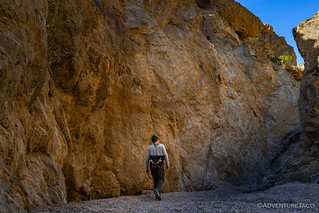
A half mile into the canyon, things started to get interesting.
Entering the narrows and rounding the first tight bend, I wasn't surprised to see a dry fall. And, while it was single, reasonably smooth surface 20 feet tall, I thought I saw a path up. That path turned out to be slightly tougher than I'd envisioned, with a couple bracing sections in a polished chute that would be extremely difficult (for me) to downclimb.
Not to worry, I told myself as I chimneyed my way up the chute, I'll just take the road down.
Then, around the next bend, I hit the second dry fall. This one - only about 10-feet tall - looked easy to scale, and I figured I'd be out of the narrows in no time.

Still not worried at this point.
It was as I rounded the two more twists in the narrows that I realized my mistake. Here, a third dry fall towered 25 feet above the ground. Like the first I'd encountered, it was obvious to me that without a rope, I'd not be climbing down this one. The problem this time was that I also had difficulty finding a route up.
Things got tense, fast. Glancing around, there was no way to escape the narrows - the walls easily rising more than 50 feet in all directions - besides figuring a way up or down the dry falls. I kicked myself for assuming I'd have access to the mining road after the first dry fall, and for not following my own rule when it comes to climbing these types of things:
Up is significantly easier than down. In making climbs like this, I have found that climbing up and then down, then up a bit further, and down again, and repeating the process helps to ensure that I never reach a point where I can't get down. It takes longer, but many times, slower is faster, and it's certainly safer.
The worst part was - I realized - that I had no idea as to the total number of these falls that I would encounter. I pondered my options for a good 10 minutes as I fired up my inReach. I didn't think I'd need to use it, but I wanted to get it searching for satellites in the off chance it was necessary.
And then I started searching for routes up the third dry fall. My first route - up an unpolished face - seemed to work well until I reached the top, at which point a car-sized boulder blocked my path, requiring me to traverse sideways, over a large ridge and into a polished chute. With no way to keep myself stuck to the wall with opposing pressures, this route wasn't going to work and I picked my way back down.
With no other choice, I considered the polished chute. I'm not a fan of these chutes because the only way to climb them is to brace myself between the walls and hope that I can apply enough sideways pressure with my hands and feet to keep from falling. Any misstep and there's nothing to grab onto; however far it might be, I'm ending up at the bottom of what is essentially a rock waterslide.
Up I went. Slowly. After what was probably less than a tense two minutes, I exited the top of the dry fall. There - to my relief - I could see the old mining road re-enter the wash. I was lucky; I'd gotten in over my head, but I was going to be OK. This time.
How this happened. A bad excuse.
It was the (too) tiny bit of research I'd done prior to this hike that got me into trouble. I'd watched a video of Tom and Julie - a couple of mine explorers who are braver than I and visit some amazing places - where they hiked up "the wash" to the Ashford Mine. In doing so, Tom mentioned hiking up the canyon and down the road, and there was a dry fall they had to climb, but it didn't seem all that bad, so I figured I'd follow in their footsteps as it were.
What I didn't realize when I was watching the video - probably because I was only partly paying attention as I tried to wrap up other details for the trip - was that they'd taken an entirely different route, through an entirely different fork of the wash, up to the mine. Of course, this fact was obvious when I fired up the video on my return and was a good reminder that no matter how much we try to convince ourselves otherwise, humans are terrible at multitasking.

At the top of the series of dry falls, this tiger rock caught my eye.

In the shadows of a nearby side-canyon, this little purple flower was ready for spring.

The side canyon.
Knowing that I'd spent more time in the narrows than I'd planned - and having gotten a late start to the hike - I funneled the adrenaline pumping through my veins into a speedier pace up the remaining mile-and-a-half of canyon to the mine. I had 90 minutes until sunset, and I wanted to make the best of it!
I arrived at the camp with an hour of light, and figured that I'd have enough time to poke around the cabins and a working or two before the sun dropped below the horizon, my signal to head back down the hillsides - this time following the much-less-treacherous mining road!

Three reasonably nice structures.
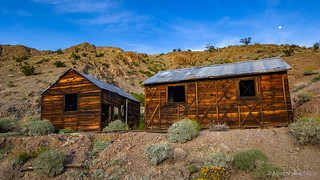
The two smaller cabins seemed like they were probably sleeping quarters.
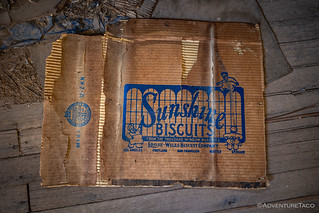
These types of biscuit boxes seem common in old mines - likely used for both the eating and then for helping to seal up drafty walls. I thought the five locations were interesting.
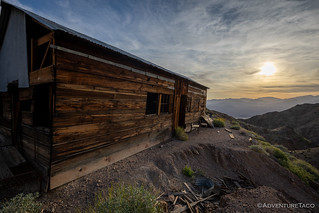
The largest cabin had the nicest view. and contained most of the artifacts.

All the bed frames had been moved into the living room.

Lost and found.

A clean kitchen.

A decade-old log book, less than a quarter full. Visitation seemed consistent, but reasonably light.
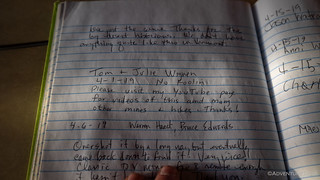

Hey, look who I found!
After poking around in the cabins - and spending more time than I should have with the log book given the speed that the sun was hurtling toward the horizon - I took a quick survey of the surroundings and decided on the direction I'd take to investigate some of the workings.
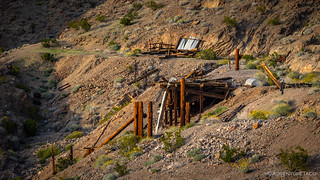
The remains of the ore bin which aggregated the ore from the adjacent main shaft and the aerial tramway.
In January 1907, Harold Ashford wandered into the Death Valley region and, attracted by the gold strikes at the Desert Hound Mine, prospected in that vicinity. Within a few months, he discovered that the Keys Gold Mining Company - owners of the Desert Hound - had failed to do the necessary assessment work on several of its claims, and Ashford started to work them on his own. It took the Keys two years to discover that someone else was working their claims but after taking Ashford to court, the judge found in favor of Ashford In January 1910. He might have been better off if he had lost.
Ashford and his brothers, Henry and Lewis, worked the mine off and on between 1910 and 1914, without good results. In November 1914, they leased the mine to B. W. McCausland and his son, Ross.
The McCauslands started to work on a large scale, and within a year, had driven a tunnel 180 feet into the side of the mountain. At the height of their operation, the McCauslands employed 28 men, had invested over $125,000, and had completed 2,000 feet of total workings.
However, despite taking out an estimated $100,000 worth of ore, the McCauslands soon discovered that the ores from the mine were not rich enough to justify their capital expenditures, and they ceased operations in September 1915.
Leased again in 1935 - to Golden Treasure Mines, Inc. - the new company looked to improve profits by taking out only the highest grade ore. This continued until 1938, when - having only shipped $18,000 of ore over three years - they gave up.
By 1938, the Ashfords were once again working the mine themselves. Now comprised of twenty-six claims, they worked a 320-foot shaft with a crosscut, a 215-foot tunnel, and a 200-foot drift. Shortly, the Ashford’s leased it again, this time to the Bernard Granville and Associates of Los Angeles. Though the new company would install a short aerial tramway to facilitate the task of consolidating the ore from the scattered shafts and tunnels to one central point for trucking down the mountain. no record of any shipments are available, and the mine shut down for good in 1941.

An old bucket from the aerial tramway.
With just enough time to explore a single adit, I picked a promising looking one with shovel head on the ground outside the portal and quickly realized I'd left my flashlight back at the Tacoma. Luckily, a combination of my phone and the small LED puck lights I'd brought along would be enough for the few hundred feet that this adit extended into the mountain, and soon I found myself wandering into the pleasantly cool air of this century old mine.
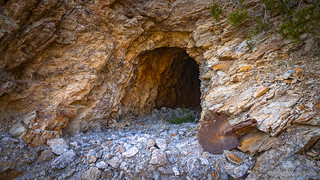
I've always found it hard to dig pure rock with a shovel. Maybe that's why Ashford wasn't successful.
As daylight faded - both inside and outside the tunnel - I could see where rail once lined the floor. Pulled out to be used elsewhere, it gave me hope that I'd picked a winner, a feeling that was reinforced as my faint phone light picked up an old ladder in the distance.
And then, confusion.

A ladder to nowhere.
I have no idea what the deal was with the ladder, but I'd had a fun time nonetheless. There were many more workings to be explored - along with the towers of the lightweight aerial tramway that once shuttled ore here - but those would need to wait for another visit. For now, it was time to head back down to camp, lest I be forced to navigate the wash in complete darkness.

As the last of the light faded away, I re-entered the wash and started the two-and-a-half-mile trek back to camp.

Winding through the upper narrows, relieved to know that I could follow the mining road past the dry falls.
Nearly 8:00pm when I pulled off my pack and started prepping for dinner, it'd been a day I wouldn't soon forget. Nearly eaten by a dinosaur, then in over my head as I climbed a canyon I believed to be reasonably easy. And, as I thought about my plan for the following morning - to hike a nearby canyon with a climb considered impossible without ropes - I wondered if the same thing would happen all over again.
The Whole Story



Great trip, now its on my list!
Thanks David! Have fun out there. The next part of this trip was to a nearby canyon that was a fun explore as well if you do make it out there!
Thanks for another fine tale and beautiful photos. Your experience with the dry waterfalls reminds me of a scary episode a friend and I had way back when we were young. We often hiked and did some rock climbing in the local mountains and on one hike decided to descend some dry falls into the canyon to save time and avoid a bunch of switchbacks. Since it was a planned hike we didn't have much climbing gear. After descending a couple of falls we ended up in an alcove by chimneying and the next drop was a couple of hundred feet! Sat & considered our fate, couldn't go back up, couldn't go down so sideways was the only option. Slowly edging sideways and upward on steep loose rock we finally escaped but it took a long while and ended our experience in the dark vowing to be more prepared next time!
As always, happy to hear you enjoyed the story and photos, John.
That's quite the experience you had - I'm very glad (and lucky) that I didn't run into anything that was a couple hundred feet!
I think many of us that thrive on the outdoor experiences we create for ourselves end up with a crazy tale or two like this. Hopefully, we're all able to get out of these situations with all but our pride intact, and with a bit more knowledge/preparation/caution for the future.
So many of these things could end much worse, but there's a balance to walk (IMO) between getting out there and "doing" and being so frightened that one just stays home or doesn't push at all.
I offer you a cautionary tale about a woman who did something very similar, climbed two waterfalls, couldn't make it up the third, but did manage to scramble up the shale on the side of the canyon to get around it, then pass the 3rd (25') falls, and look for a way back into the canyon, which she did. The wrong way. When the cliff side let go and down she went 20 feet, broker both legs, ankle, foot....eight hours later, search and rescue extracted her and got her to LVU hospital, and 18 months later she walked again (not well). She did NOT have a SPOT or InReach (but carries one always now). However was told that in the canyon she was in, it would not have worked anyway.
So happy to hear your story has a better ending!
Hi Karyn, Thanks for the cautionary tale! I've heard several stories similar to yours, and in general pride myself on taking reasonable precautions to not end up in a situation like this. I covered why I thought climbing that first fall in this story was OK - having seen someone else "do it," and then use the mining road down, but it was a good reminder for me that I need to be diligent (pay attention) in my research, since if I had been this time, I'd have realized that they took a different route!
In general, I think there is a balance to strike - between being too cautious and limiting adventure too much, and being too adventurous and ending up in a really bad situation. I hope I'm striking that balance correctly, given that this is the first time I've found myself in a situation like this (and one that I probably could have figured other ways out of or simply waited for someone else to come along since this isn't the most remote place in the park), but it certainly gave me a good adrenaline rush in the moment!
Hope you're enjoying the stories; if you love Death Valley, there are a lot more where this one came from: https://adventuretaco.com/tripdest/death-valley/ 👍
I absolutely get your perspective, and it was not my first nor last mis-adventure in DV. I got a lot smarter, but I tend to learn the hard way LOL! My biggest takeaway was when relying on written material, as I was, and have since, remember it is usually obsolete before printed (especially for off-roading) due to ever-changing conditions. The route I took was supposed to be 'easy enough for my 60 year old mom' to take according to the book, which had been published 2 years prior. But I made some bad decisions about continuing, so its on me. DV rangers and SAR, however are awesome!
I can tell you are thoughtful and cautious in your adventures, but recognize you can get hit by a bus crossing the street. So happy you are getting out there and enjoying. I have much of your blog, and will continue to do so! Thank you for sharing places I will sadly never be able to visit.
Thanks for responding!
Karyn
As always a great story, sometimes the adrenaline rush is what keeps us going and being relatively safe. As a former adrenaline junky, I understand your motives. As they say, there is more life near death, just don't cross that line.
The photos were great, especially the one at your camp looking across the wide expanse to the mountains and seeing a road up the mountainside. Be brave and cautious and enjoy your discoveries.
Be blessed!
I've never heard that saying before Kenny, but it certainly resonates! And I'm not sure I'd refer to yourself in the "past tense" quite yet on the adrenaline junkie front!
As always, happy to hear you enjoyed. Spring is coming north, if slowly.
Enjoy your travels and photos. What camera and lens do you use. Your photos are alway top notch.
Hi Gary, glad you're enjoying! Here's my photo setup and my approach to taking photos:
Setup: https://adventuretaco.com/involuntary-evolution-to-a-new-camera-and-glass-canon-r6/
Approach: https://adventuretaco.com/if-you-take-enough-photos-some-are-bound-to-be-decent/
Another fantastic trip report. Quite inspiring...
The photo of the ladder to nowhere is exquisite. I just ordered the puck lights, they look both functional and FUN.
Thanks for taking us on your trip!
Thanks Séamas, glad you enjoyed it! That ladder was an and awesome find, and those puck lights are a huge time sink, but a ton of fun! I found that it’s easy to get too fancy with them, so I try To keep the lighting more simple now if I can.